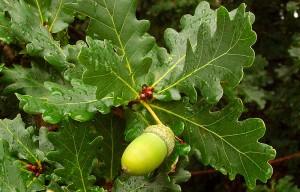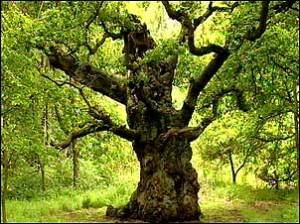OAK (Quercus robur)
Plant family: Beech family (fagaceae)
 Parts Used: Bark, leaves, acorns, galls (“oak apples” created by gall wasps on leaves).
Parts Used: Bark, leaves, acorns, galls (“oak apples” created by gall wasps on leaves).
Soil and Environment: Hedgerows, woods, parkland. Copes well in moist and even poor soil. Interbreeds with other oak, such as sessile and downy oak. Grows very slowly.
Description: 130ft – 160ft (40m – 50m). Lives between 400 – 1,000 years. Circumference to approximately 30ft (10m). Lobed leaves in ovoid-shape. Scaled grey/green trunk with warty branches, scaly “capped” acorns longer than American cousin. Male flowers in yellow-green catkins, female flowers unassuming – both flowers grow on same tree. Due to size, creates a greenish light around it when found in a forest, as it opens up the canopy around it to let light in. Quiet tree, noble stillness, grand presence. Irregular-shaped crown with branches starting low down on trunk. Galls are smooth, globular, brown and perforated.
Used for building homes, ships, furniture, etc. Bark used in tanning leather and dyeing fabric. Acorns used to feed pigs (and humans when food was scarce). Galls used to make ink. The wood is good for burning and for making charcoal. Oak trees have sheltered many famous outlaws, including Robin Hood and Charles II. Oak is the second Ogham in the aicme of Huath. Oak forests covered most of Europe in vast expanses. It is one of the seven “nobles of the wood” in Brehon law. Associated in Celtic lore with thunder and lightning, oak trees often survive lightning strikes. Their roots reach as deep into the ground as their branches reach high into the sky. Oak was the first tree species to be protected by legistation. It is the chieftan tree of the Druids: Druid means “wisdom of the oak”. The Oak King battles the Holly King at each solstice; The Oak King is the god of summer. Lightning struck oak trees were important in Druid and Celtic magic. Sacred to the goddess Brighid, her original sanctuary in Kildare was a grove of oak trees: Cill Dara, the church of the oak tree. In Greece the rustling of the leaves and branches were used for divination. Woodhenges of Neolithic or Bronze Age were made of oak, such as Seahenge in Norfolk. Sometimes considered the World Tree in certain cultures, it was an axis mundi. Neolithic trackways of oak still exist in Britain. Oak used to be on sixpences and shillings. King Arthur’s table at Winchester is cut from a single piece of oak-tree trunk.
Chemical constituents:
Tannins, tanning acids, minerals.
Astringent and good for tightening, drying, binding and toning tissue, reducing excess discharge. Good for diarrhoea, dysentery, eye, mouth and throat inflammations as well as inflammation in the mucous membranes of the digestive tract. Good for burns, sores, bleeding. Also good for coughs and colds. Anti-microbial and anti-septic. Also good for sweaty feet, chilblains and anal tears (taken as bark decoction in room temperature bath). Acorn coffee aids poor digestion. Used homoeopathically for alcoholism. Helps reduce fever. Good hair rinse for dandruff and hair loss. Compresses soaked in tea can shrink goiters and glandular inflammation. Anti-inflammatory.
Combinations:
Oak bark decoction with nettle and yarrow make a good women’s tonic. Bruised leaves when applied with comfrey leaves help heal bruises and sprains.
Usage:
Leaves for tea and tincture, bark as decoction, acorns ground and roasted for coffee substitute. Tea and decoction internal use: 2 tsps dried or 3 tsps fresh leaf/bark per cup boiled water up to 3 times per day. Tincture: 1 tsp three times per day. Galls as tincture internally for severe diarrhoea and dysentery. Use decoction as local astringent externally for haemorrhoids. Bruised leaves for first aid treatment in bruises, swelling and sprains.
Contraindications:
Possible contraindication when used with morphine. Possible antagonist to nicotine sensitivity.
Spiritual Aspects:
Oak is sacred to many gods. The Proto-Indo-European word for oak, dorw, became the word for “door”. Oak is a doorway between the worlds, as it lives between the worlds (high branches, deep roots). Celtic priests ate acorns to aid in powers of divination. Oak was popular in the funeral ceremonies of ancient Celts. Acorns kept in the home or carried on a person brings good luck. Oak teaches of strength, even when the worst happens (as they often survive lightning strikes). For Druids they symbolise the ideal way of life, with branches reaching towards the heavens while feet are rooted deeply in the earth. Water found in tree nooks and crannies can provide a good vibrational essence for empowerment, fighting great difficulties, loss of hope or the draining of energy. Oak helps develop inner sovereignty. It can leads to a greater ability for kindness and compassion. Promotes personal responsibility. Spirit ally to connect you with other worlds. Oak is the doorway to new worlds and new perception.





